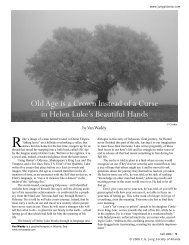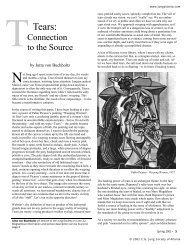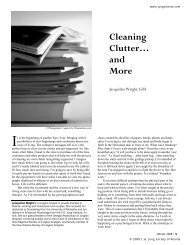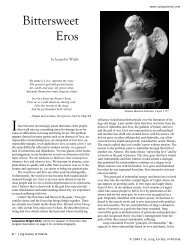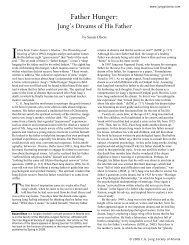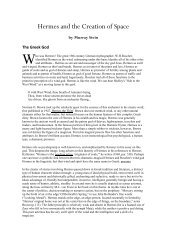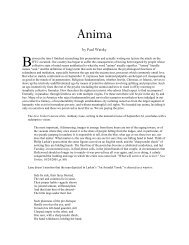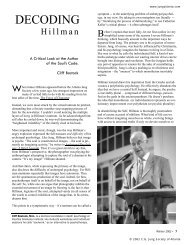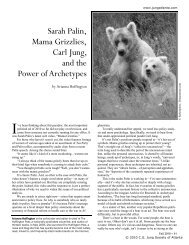Archetypal Patterns: Snow White - C.G. Jung Society of Atlanta
Archetypal Patterns: Snow White - C.G. Jung Society of Atlanta
Archetypal Patterns: Snow White - C.G. Jung Society of Atlanta
You also want an ePaper? Increase the reach of your titles
YUMPU automatically turns print PDFs into web optimized ePapers that Google loves.
<strong>Archetypal</strong><br />
<strong>Patterns</strong>:<br />
<strong>Snow</strong> <strong>White</strong> –<br />
She Was Quite<br />
A Ninny,<br />
Wasn’t She?!<br />
Jutta von Buchholtz, PhD<br />
ecently I re-read the fairy tale “<strong>Snow</strong> <strong>White</strong> and the<br />
R<br />
Seven Dwarfs.” To my surprise, I was getting<br />
rather impatient with the heroine. Why did she<br />
adamantly refuse to understand that her step mother<br />
was trying to do her in? A few weeks later, my friend Susan<br />
Olson and I talked about <strong>Snow</strong> <strong>White</strong> and Susan recalled a<br />
Zurich analyst who observed laconically: “<strong>Snow</strong> <strong>White</strong> … she<br />
was quite a ninny, wasn’t she?!” That remark verified my most<br />
recent impression <strong>of</strong> the story. I happily grinned at the irreverence<br />
and decided to explore the fairy tale further. The result is<br />
this—naturally rather limited—attempt at a psychological view<br />
<strong>of</strong> the tale. My delight about the analyst’s remark led the way.<br />
I love fairy tales. I first heard fairy tales in a dark underground<br />
storage space turned bomb shelter during WW II in my<br />
grandmother’s house in Gottingen. The empty cellar still<br />
smelled somewhat <strong>of</strong> coals and apples—reminders <strong>of</strong> a long<br />
gone security which was in stark contrast to the reality <strong>of</strong> constantly<br />
howling sirens, a warning that yet another air raid was in<br />
progress which had sent us scurrying once again in the dark <strong>of</strong><br />
night down into the basement. My grandmother would tell<br />
fairy tales into the dark as we huddled near to her. The soothing<br />
effect <strong>of</strong> this ritual promoted a pr<strong>of</strong>ound sense <strong>of</strong> comfort<br />
and safety for us children and, as I now believe, for the storyteller<br />
herself. While the bombs took their shrilly purposeful<br />
Jutta von Buchholtz, PhD, is a Swiss Diplomat <strong>Jung</strong>ian analyst. Her<br />
home is Birmingham, Alabama, where she has a private practice.<br />
She is a frequent lecturer at the <strong>Jung</strong> <strong>Society</strong> <strong>of</strong> <strong>Atlanta</strong>.<br />
www.jungatlanta.com<br />
aim at us, we were safely under ground and under the spell <strong>of</strong><br />
these old stories. The ritual telling as well as the stories’ content<br />
spread a sense <strong>of</strong> being held by a mysterious, ancient<br />
patterning force—something larger than life which I later<br />
would understand as archetypal energies emanating from a<br />
power greater than life as we know it and which I refer to as the<br />
Self.<br />
It took Wilhelm and Jakob Grimm fifteen years to collect<br />
and edit the stories from story tellers around the German country<br />
side, primarily in Hessia, the county that included the town<br />
<strong>of</strong> Gottingen where they taught at the University. Almost 200<br />
years ago (1812) the brothers Grimm published the first volume<br />
<strong>of</strong> what was innocently entitled “Kinder und Hausmarchen”<br />
(Fairytales for Children and Use Around the Home).<br />
The second volume, which was published two years later, is<br />
almost entirely based on the stories Frau Viehmannin reported.<br />
Wilhelm and Jakob were impressed with the straightforward<br />
honesty and naturalness <strong>of</strong> the tales. A long time ago, when<br />
listeners crowded close to solid tiled stoves that warmed an<br />
entire thatch ro<strong>of</strong>ed old farm house in Germany, these drastic<br />
stories spoke <strong>of</strong> ancient truths, warming the intent listeners—<br />
who usually were adults rather than children - with the assurance<br />
that evil would not go unpunished, that good would win<br />
out and that there was order and justice in the world. In the<br />
foreword to the second volume <strong>of</strong> the fairy tales the brothers<br />
Grimm regretted that the custom <strong>of</strong> story telling was on the<br />
wane. They bemoaned that with the demise <strong>of</strong> the story telling<br />
ritual, a tradition which nurtured soul, was doomed. They<br />
Summer 2007 • 5<br />
© 2007 C.G. <strong>Jung</strong> <strong>Society</strong> <strong>of</strong> <strong>Atlanta</strong>
specifically remarked on a powerful yet humble sense <strong>of</strong> grace<br />
that permeated these stories—a connection to ground and a<br />
deeper source <strong>of</strong> spiritual nourishment. In the United States we<br />
are just now—almost 200 years later - beginning to appreciate<br />
the therapeutic power <strong>of</strong> story telling. Oneal Isaac <strong>of</strong> Baton<br />
Rouge, Louisiana and Kathryn Tucker Windham <strong>of</strong> Selma,<br />
Alabama are two outstanding living story tellers I know.<br />
<strong>Jung</strong>ian analyst Marie Louise von Franz, who spent her life<br />
interpreting fairy tales from around the globe, understood them<br />
as expressions and images <strong>of</strong> archetypal energies. She said that<br />
fairy tales are “… the purest and simplest expression <strong>of</strong> collective<br />
unconscious psychic forces.” I wondered how do these<br />
“expressions <strong>of</strong> collective unconscious forces” express themselves<br />
in our everyday life—where can we find them? As an<br />
example, there is the 13 th fairy in “Sleeping Beauty.” I find her<br />
a convincing archetypal representation for the personal feeling<br />
toned “rejection complex.” It plays itself out in the desire for<br />
revenge and retribution when we feel left out, or uninvited.<br />
Another example: we know what it feels like to wear shoes that<br />
are way too small, an image for finding ourselves in a situation<br />
that is painfully uncomfortable, a bad fit. The shoe, literally,<br />
does not fit Cinderella’s two step sisters, who were ordered to<br />
amputate their toes and heels respectively, in order to win an<br />
acceptable bridegroom. An incorrect fit! Fairy tales express<br />
ancient psychological wisdom in symbolic form. These images,<br />
characters and stories are unlike novels: they are one<br />
dimensional, cartoon like, a blueprint for deeper meaning,<br />
powerfully energetic abstractions, just like the images and<br />
actions in dreams. Fairy tales are a good “training ground” for<br />
working symbolically with psychic material.<br />
A storyteller meanders, circumambulates around themes.<br />
Time and leisure are necessary to be able to hear that “small<br />
inner voice” which speaks to us in our personal responses to<br />
archetypal material as we find it in fairy tales. This is difficult<br />
since we live in a fast-paced, extraverted, materialistic culture.<br />
And now, after this little introduction, it is time to meander<br />
back to the point <strong>of</strong> departure, the fairy tale <strong>of</strong> <strong>Snow</strong> <strong>White</strong>. I’ll<br />
tell it the way I heard it from my grandmother in that dark<br />
bomb shelter.<br />
nce upon a time, in the middle <strong>of</strong> winter, a<br />
O<br />
queen sat by a window whose frame was<br />
made <strong>of</strong> ebony. She was sewing. Suddenly<br />
she accidentally pricked her finger<br />
with the needle and three droplets <strong>of</strong> red blood fell<br />
into the fresh white snow. The queen sighed: “I wish I<br />
had a little girl, white as snow, red as blood and black<br />
as ebony.” Within a year she gave birth to a little girl<br />
whose hair was as black as ebony, whose skin as white<br />
as snow and whose lips were as red as blood. She<br />
named her daughter <strong>Snow</strong> <strong>White</strong>. Soon thereafter the<br />
queen died. A year passed by and the king married<br />
again. This new queen prided herself on her beauty.<br />
She also had a magic mirror which she consulted<br />
regularly. She would ask it: “Mirror, mirror on the<br />
wall, who is the fairest <strong>of</strong> them all?” The mirror would<br />
respond that she was the fairest in the land and the<br />
queen would be content.<br />
<strong>Snow</strong> <strong>White</strong> grew up to be a lovely young girl.<br />
When she was about seven years old, the mirror responded<br />
to the queen’s question that <strong>Snow</strong> <strong>White</strong> was<br />
6 • <strong>Jung</strong> <strong>Society</strong> <strong>of</strong> <strong>Atlanta</strong><br />
www.jungatlanta.com<br />
now the fairest. The queen was hugely upset and as<br />
time passed she became ever more afraid and angry.<br />
Finally she ordered one <strong>of</strong> her huntsmen to take <strong>Snow</strong><br />
<strong>White</strong> into the forest and kill her. The hunter tried to<br />
obey, but the girl begged and pleaded for her life. His<br />
heart s<strong>of</strong>tened to her beauty and her pleas. He told her<br />
to run into the woods and never return. He then killed<br />
a young pig for its heart and liver which he presented<br />
to the queen as the required pro<strong>of</strong> <strong>of</strong> his deed. The<br />
queen was satisfied.<br />
<strong>Snow</strong> <strong>White</strong> ran into the forest and got more and<br />
more lost. Suddenly, close to nightfall and at the end<br />
<strong>of</strong> her strength, she stumbled upon a little cottage. She<br />
went in and found a tiny table neatly set with seven<br />
plates, seven bowls, seven cups, seven forks, seven<br />
spoons and seven knives. Along the wall <strong>of</strong> the room<br />
were lined up seven little beds, properly made up with<br />
white sheets. She ate a bit <strong>of</strong>f every plate, drank a few<br />
drops out <strong>of</strong> every cup, tried all the beds—and the last<br />
one fit her. She fell sound asleep.<br />
Soon the seven dwarfs, whose house this was,<br />
came home from their work in the mines where they<br />
were digging for iron ore and gold. They found <strong>Snow</strong><br />
<strong>White</strong> and invited her to stay with the proviso that she<br />
would do all the household chores for them. She<br />
happily agreed. They warned her that the queen<br />
would surely try to continue to do her harm.<br />
s she did regularly, the queen consulted her<br />
A<br />
mirror and learned that <strong>Snow</strong> <strong>White</strong> was<br />
still alive and living with the seven dwarfs<br />
at a distance <strong>of</strong> seven mountains from her<br />
castle. She was furious and decided to use a lace to<br />
kill the girl. She disguised herself as an old peddler<br />
woman, crossed the seven mountains, appeared in<br />
front <strong>of</strong> the dwarfs’ cottage, knocked at the door and<br />
<strong>Snow</strong> <strong>White</strong> opened. The queen easily persuaded the<br />
innocent girl to buy the colorful lace. Unsuspecting<br />
<strong>Snow</strong> <strong>White</strong> even asked to be laced up by her! The<br />
evil queen then laced her victim up so tightly that the<br />
© 2007 C.G. <strong>Jung</strong> <strong>Society</strong> <strong>of</strong> <strong>Atlanta</strong>
girl fell to the floor, unable to breathe, apparently<br />
dead. When the dwarfs returned home that evening,<br />
they found <strong>Snow</strong> <strong>White</strong> lying on the floor as if dead—<br />
but they quickly noticed that she was laced up too<br />
tight and cut the lace. Soon <strong>Snow</strong> <strong>White</strong> came to and<br />
was able to breathe. Again the dwarfs warned her—<br />
and again the queen found out that <strong>Snow</strong> <strong>White</strong> was<br />
still alive. This time the queen’s persuasive power and<br />
a very pretty comb proved stronger than the dwarfs’<br />
warning. The disguised wicked queen stuck the poisoned<br />
comb into the girl’s lovely black hair and again<br />
<strong>Snow</strong> <strong>White</strong> fell to the floor as if dead—the dwarfs<br />
found the poisonous comb, pulled it out and saved the<br />
girl. They warned her even more strenuously not to<br />
buy anything from anyone and to let no one into the<br />
house. <strong>Snow</strong> <strong>White</strong> promised to heed their warning.<br />
Again the queen found out that her scheme had failed.<br />
This time she poisoned an apple which she took to the<br />
cottage. <strong>Snow</strong> <strong>White</strong>—persistently and tiresomely<br />
naïve!—took a bite <strong>of</strong> the apple and fell to the floor<br />
dead. The envious queen had won, as the mirror<br />
assured her. The seven dwarfs were inconsolable.<br />
<strong>Snow</strong> <strong>White</strong> looked so beautiful and as if she were<br />
only asleep—they were unable to put her into a grave.<br />
Instead, they had a glass c<strong>of</strong>fin built and took turns<br />
watching over it by day and night.<br />
One day a prince came into that part <strong>of</strong> the woods,<br />
saw <strong>Snow</strong> <strong>White</strong> in her c<strong>of</strong>fin and fell in love with<br />
her. He asked the dwarfs to allow him to take her with<br />
www.jungatlanta.com<br />
him, but neither gold nor other gifts could persuade<br />
them to give up the c<strong>of</strong>fin with its precious content.<br />
But, when the prince said he would surely die without<br />
her because he loved her so, they took pity and allowed<br />
him to have his men carry the c<strong>of</strong>fin <strong>of</strong>f to his<br />
castle. But the prince’s men were clumsy and accidentally<br />
stumbled over a root. The c<strong>of</strong>fin was jarred<br />
which dislodged the poisonous piece <strong>of</strong> apple in <strong>Snow</strong><br />
<strong>White</strong>’s throat. Soon she was sitting up, wondering<br />
where she was. She rode <strong>of</strong>f with the prince to his<br />
castle to celebrate a splendid wedding. They also<br />
invited the evil step mother who, in the meantime, had<br />
learned that the young queen <strong>of</strong> the neighboring country<br />
was more beautiful than she. She trembled with<br />
rage and fear but set <strong>of</strong>f to the wedding ceremony<br />
anyway. There she discovered that the young queen<br />
was none other than <strong>Snow</strong> <strong>White</strong>! The evil queen’s<br />
feet were forced into red hot iron shoes and she was<br />
made to dance in them until she fell to the ground,<br />
dead.<br />
his is a long and complex fairy tale. Not only the<br />
T<br />
content but the ritual telling <strong>of</strong> the story can have a<br />
therapeutic effect. As I mentioned earlier, there is a<br />
sense <strong>of</strong> pr<strong>of</strong>ound security in the rhythm <strong>of</strong> the<br />
story as it is told (not so much when it is read, I’ve found!): we<br />
children in the cellar knew what the outcome would be, and<br />
happily anticipated the jingles, repetitions, and rhymes within<br />
the story. Storytelling implies an unending chain, an underly-<br />
Summer 2007 • 7<br />
© 2007 C.G. <strong>Jung</strong> <strong>Society</strong> <strong>of</strong> <strong>Atlanta</strong>
ing rhythmic cycle which is natural to our universe and which<br />
keeps the dread <strong>of</strong> danger and <strong>of</strong> death at bay: everything<br />
belongs and has its place in the fullness <strong>of</strong> nature’s patterns.<br />
There is not the space here to fully explore all the symbols<br />
and so I had to skip many interesting images and issues. For<br />
example, I will not explore why the dwarfs went to work and<br />
left the girl at risk—but watched over her once she is dead in<br />
the c<strong>of</strong>fin? Why did the stepmother bring an apple to tempt<br />
<strong>Snow</strong> <strong>White</strong> rather than a pear, a peach or even a banana? I will<br />
skip associations to the motif <strong>of</strong> the mirror, the color symbolism,<br />
the prince, etc. It would also be very interesting to compare<br />
the fairy tale to the Walt Disney cartoon version and<br />
explore the differences in the collective.<br />
<strong>Jung</strong>ians look at fairy tales, dreams and life symbolically.<br />
We read symbols to understand the personal complexes and<br />
stories that are based on archetypal patterns which inform them.<br />
We try to glean the underlying message from the personal or<br />
collective unconscious as it might relate to the individuation<br />
process. Often the information we thus receive is complementary<br />
to our rational approach to everyday reality, providing food<br />
for our soul, a nourishing symbolic soul food stew for individuation!<br />
The story starts out with a queen, alone. A sharp object<br />
“accidentally” penetrates her skin, draws blood and a pregnancy<br />
results. How sexually explicit can it get? The queen immediately<br />
fantasizes a baby into existence—a girl made up <strong>of</strong> cold<br />
white snow, hard black ebony and blood-red lips. Of the color<br />
symbolism here I just want to mention that white and especially<br />
snow white has a cold, virginal quality. The insistence on the<br />
whiteness <strong>of</strong> the girl implies that darker, shadowy aspects are<br />
not wished for by the biological mother; they are missing in her<br />
child, although the black <strong>of</strong> the hair hints at deep darkness and<br />
the blood red lips imply sensuousness. “<strong>Snow</strong> <strong>White</strong>”—the<br />
name alone sets the stage and the theme: the story will be about<br />
the heroine’s - or a female psyche’s - confrontation with and<br />
integration <strong>of</strong> shadow aspects. We will accompany her growth<br />
from innocent girl to mature married queen. The girl’s virginal<br />
and cold ethereal beauty necessarily constellated an evil queen.<br />
The innocent maiden and evil stepmother point to a polarization<br />
in a psyche, which plays itself out in projections. To make an<br />
analogy to our present day issues: could it be, here in the South,<br />
that our black brothers and sisters are carrying—<strong>of</strong> necessity—<br />
some <strong>of</strong> our unintegrated shadow aspects? Or, continuing with<br />
the theme <strong>of</strong> unintegrated and therefore projected shadow:<br />
what does it mean when we say that the preacher’s children will<br />
be “wild?” In this fairy tale the libido connected with the<br />
evilness <strong>of</strong> the queen is strong enough to initiate a development<br />
in a female psyche—or the anima.<br />
This brings us to the stepmother. Stepmothers are proverbially<br />
“evil” and “bad”. In many fairy tales there are two<br />
mother figures: one is totally and absolutely good while the<br />
other is just as unequivocally dark, sinister or evil. Our tale<br />
shows a split in the mother archetype and in the feminine.<br />
What does projected polarization look like in everyday life?<br />
The old adage “The pot calling the kettle black” is an excellent<br />
example as is seeing the splinter in another’s eye but being<br />
oblivious to the beam in our own.<br />
The wicked queen is envious <strong>of</strong> <strong>Snow</strong> <strong>White</strong> because the<br />
young girl is becoming very beautiful, eventually more beautiful<br />
than the queen herself. Jealousy and envy between a mother<br />
and daughter are taboo topics in our society. Our understanding<br />
8 • <strong>Jung</strong> <strong>Society</strong> <strong>of</strong> <strong>Atlanta</strong><br />
www.jungatlanta.com<br />
<strong>of</strong> motherhood heavily emphasizes a self-sacrificing mother as<br />
the desideratum and we label that the “positive” pole <strong>of</strong> the<br />
archetype. We simply cannot fathom that a mother could<br />
possibly be envious and jealous <strong>of</strong> her daughter. Only a wicked<br />
step mother is capable <strong>of</strong> such “unnatural” impulses. Yet, the<br />
older woman’s envy <strong>of</strong> the younger one’s beauty, sex appeal,<br />
desirableness is obvious in our culture, attested to by the booming<br />
cosmetic industry. Many a middle aged woman considers it<br />
a fine compliment if she is told that she looks as young as her<br />
daughters. We consider, as did the evil queen, beauty to be one<br />
<strong>of</strong> our most precious commodities, an important power tool in<br />
our lives. The myth <strong>of</strong> the judgment <strong>of</strong> Paris illustrates that the<br />
need to be the most beautiful is thought to be an ancient attribute<br />
<strong>of</strong> the feminine. Hera, Pallas, Athena, and Aphrodite, vied<br />
for the title <strong>of</strong> the most beautiful woman. This Olympian beauty<br />
contest resulted in the tragic Trojan War. When a mother<br />
notices that her daughter gets the admiring male attention while<br />
they stroll along a shopping mall or down the Champs Elyssee,<br />
she is envious … if she is brave enough to face her own shadow<br />
by acknowledging these feelings. If we understand this fairy<br />
tale to be about female maturation (or the development <strong>of</strong> the<br />
anima) in symbolic terms, this story could be a case study in<br />
maternal jealousy in its most pernicious and pathological form.<br />
<strong>Snow</strong> <strong>White</strong> and the queen are connected by their need to<br />
be beautiful. Their pursuit <strong>of</strong> beauty is potentially deadly for<br />
both: <strong>Snow</strong> <strong>White</strong> naively wants to adorn herself with a lace<br />
and a comb. She is as yet too young to properly handle these<br />
implements <strong>of</strong> female vanity. It reminds me <strong>of</strong> the sad story<br />
and murder <strong>of</strong> little Jonbenet Ramsay, who was a child beauty<br />
queen, dressed and made up like an adult. The queen’s obsession<br />
with reigning as the most beautiful in the land leads her to<br />
the lethal dance in red hot iron shoes. In his essay “Eros and<br />
Psyche”, Erich Neumann delineates three kinds <strong>of</strong> beauty: the<br />
self-contained beauty <strong>of</strong> a young girl, oblivious to anything but<br />
herself, the seductive beauty <strong>of</strong> Aphrodite which has a natural<br />
purpose in mind, and the beauty <strong>of</strong> a woman in love who<br />
wishes to be beautiful for her beloved (p. 123). <strong>Snow</strong> <strong>White</strong><br />
will have to develop a beauty beyond that first kind.<br />
ne striking aspect <strong>of</strong> the story is the prominence <strong>of</strong><br />
O<br />
the number seven. The girl is seven years old when<br />
the mirror first informs the queen that she has a rival<br />
in her own, deadly beauty contest; there are seven<br />
dwarfs and these seven little men live seven mountains removed<br />
from the queen’s castle. Because the number seven<br />
seems central, I want to look at its symbolism; to do so I consulted<br />
several Dictionaries <strong>of</strong> Symbols.<br />
Seven corresponds to the seven days <strong>of</strong> the week, the seven<br />
planets, seven rungs <strong>of</strong> perfection, seven sphere or celestial<br />
stairs, the seven petals <strong>of</strong> the rose, the seven branches <strong>of</strong> the<br />
shaman’s cosmic and sacrificial tree and so on. Seven denotes<br />
the fullness <strong>of</strong> the planetary and angelic orders, the fullness <strong>of</strong><br />
the heavenly mansions, the fullness <strong>of</strong> the moral order and the<br />
fullness <strong>of</strong> the energies and principles <strong>of</strong> the spiritual orders. It<br />
symbolizes the dynamic perfection <strong>of</strong> a complete cycle: each<br />
phase <strong>of</strong> the moon lasts for seven days and the four phases <strong>of</strong><br />
the moon (4 x 7) complete a cycle. Seven is a worldwide symbol<br />
<strong>of</strong> a dynamic wholeness. It indicates the passing from the<br />
known to the unknown: one cycle ends, but what will succeed<br />
it? The I-Ching is based on that cyclical pattern. The centrality<br />
and dynamics associated with the number seven in connection<br />
© 2007 C.G. <strong>Jung</strong> <strong>Society</strong> <strong>of</strong> <strong>Atlanta</strong>
to <strong>Snow</strong> <strong>White</strong> point to the development <strong>of</strong> a girl from preadolescence<br />
to maturity. During the first phase <strong>of</strong> life—birth to<br />
pre-adolescence—<strong>Snow</strong> <strong>White</strong> lives in her parental castle<br />
literally as well as psychologically. A threatening step<br />
mother’s increasingly malevolent energy (suitable image for a<br />
powerful negative mother complex) propels the heroine into the<br />
next, the transitional phase. During this phase the young girl is<br />
being prepared for her life as an adult, as a married queen. In<br />
order for her to understand fully all aspects <strong>of</strong> life, she’s<br />
“dropped” into the woods, at a distance <strong>of</strong> seven mountains -<br />
seven worlds! - away from the castle. She lives in a secret<br />
world. If you have had teenage children, you may have noticed<br />
that they, too, live in their own secret world. There they struggle<br />
with powerful, <strong>of</strong>ten chaotic inner urges. Their absolutely<br />
messy rooms so clearly show what goes on inside them.<br />
<strong>Snow</strong> <strong>White</strong> has to spend this transitional time in service to<br />
seven little men. She has to do routine, boring, daily chores,<br />
humble tasks and that activity grounds her. In his article on<br />
“Individuation as a Journey <strong>of</strong> Grief, Grace and Glory”, Bud<br />
Harris points to the connection between humility and humus,<br />
between ground and the ground <strong>of</strong> our being which is to the<br />
earth, where things can grow. The stay with the dwarfs emphasizes<br />
this close connection to ground, to potential for growth<br />
and change. The danger for <strong>Snow</strong> <strong>White</strong> lies in her stubborn<br />
adherence to ignorance and innocence—in modern day clinical<br />
terms we would call this “denial” <strong>of</strong> the reality <strong>of</strong> evil. The<br />
lace and the comb and finally the apple slowly infect her with<br />
the shadowy substance that has formerly been only the queen’s.<br />
The dwarfs warn her about the queen. Working deep in the<br />
earth, they have an appreciation <strong>of</strong> the dark, more instinctual<br />
aspects <strong>of</strong> human nature. They understand what makes the<br />
queen tick and repeatedly warn the girl <strong>of</strong> the impending danger.<br />
The girl needs to know about the danger inherent in beauty<br />
www.jungatlanta.com<br />
and become “dirtied” with the uglier sides <strong>of</strong> life. Like a<br />
hunter, who needs to know intimately about his prey’s life style<br />
in order to have a successful hunt, <strong>Snow</strong> <strong>White</strong> needs to learn<br />
about all aspects <strong>of</strong> life, which includes an understanding <strong>of</strong> the<br />
dangers <strong>of</strong> beauty. Only then can she be a truly mature queen.<br />
In this fairy tale the dwarfs are a helpful, positive force—<br />
which is not always the case. Carl <strong>Jung</strong> thought <strong>of</strong> the dwarf as<br />
a representation <strong>of</strong> natural wisdom, sort <strong>of</strong> street-smartness.<br />
They are clarifications <strong>of</strong> hidden forces <strong>of</strong> nature as well as<br />
teachers and foster parents. After his mother Siglinde had died,<br />
Siegfried was raised by dwarfs. <strong>Jung</strong> also connects dwarfs with<br />
dactyls and Cabiri which have a phallic and creative aspect. It<br />
seems important to me that at this point in her development<br />
<strong>Snow</strong> <strong>White</strong> is introduced to masculine creative energy in a<br />
diminutive form preparatory to the union with the prince. <strong>Snow</strong><br />
<strong>White</strong>’s past understanding <strong>of</strong> the masculine was limited to an<br />
absentee father and an encounter with a kindly huntsman. (He<br />
would be an image for feeling and related masculine energy.)<br />
At medieval courts, dwarfs, jesters and buffoons were <strong>of</strong>ten<br />
the only mouthpiece for the naked truth: they were reality<br />
checks for royals; they serve that very same function in this<br />
fairy tale! The seven dwarfs are closely linked to nature whose<br />
secrets they are said to know as they toil underneath the surface<br />
in the belly <strong>of</strong> the Great Mother Earth. (Again, the sexual<br />
innuendo is striking!) I wondered about an equivalent in today’s<br />
world for being in service to seven tidy dwarfs. Some<br />
time ago a young woman, beautifully educated and sophisticated,<br />
consulted me: she was deeply depressed and had tried<br />
various workshops and meditative practices for help. Nothing<br />
worked. I suggested a daily routine <strong>of</strong> ordinary household<br />
chores. This was not at all palatable to her, but she was desperate<br />
and so she tried. After several weeks she reported feeling<br />
better and a few months later she even took on a humble job,<br />
way beneath her fine college education. After some more<br />
months she reported feeling grounded, deeply connected with<br />
herself, no longer depressed.<br />
<strong>Snow</strong> <strong>White</strong> failed to listen to the dwarfs three times. Why<br />
was she such a “ninny?” I have wondered whether she needed<br />
to absorb some <strong>of</strong> the queen’s “piss and vinegar” attitude (by<br />
way <strong>of</strong> the poisoned comb and apple) in order to become a well<br />
rounded queen. Curiosity and disobedience seem to represent<br />
the feminine as a subversive element. Why did Eve disobey<br />
when everything was hunky-dory in paradise? Why did Psyche<br />
open the box <strong>of</strong> ointment she was strictly admonished to leave<br />
closed? Why did the young wife <strong>of</strong> Bluebird open the forbidden<br />
door? Erich Neuman suggests that irresistible feminine curiosity<br />
mingled with vanity is a hallmark <strong>of</strong> the feminine psyche. It<br />
is the very failure to obey that brings victory, an increase in<br />
consciousness. By being disobedient <strong>Snow</strong> <strong>White</strong> not only gets<br />
inoculated with the necessary and crucial amount <strong>of</strong> poison but<br />
she also demonstrates an emancipation from the dwarfs’ dictates.<br />
She learns about the pernicious dangers inherent in<br />
beauty, an increase in consciousness which nearly costs her life.<br />
Finally the queen is successful and <strong>Snow</strong> <strong>White</strong> dies—this<br />
time she is truly dead. The dwarfs are unable to revive her.<br />
Looked at symbolically, she had finally died to her former way<br />
<strong>of</strong> being in the world and in a sense was incubating her new self<br />
in the c<strong>of</strong>fin. Her time <strong>of</strong> being a ninny, a Kore, was over.<br />
Interestingly it is an apple that finally does her in—and a few<br />
associations to apple can help elaborate the theme <strong>of</strong> feminine<br />
maturation. Eating <strong>of</strong> the apple <strong>of</strong> the knowledge <strong>of</strong> the differ-<br />
Summer 2007 • 9<br />
© 2007 C.G. <strong>Jung</strong> <strong>Society</strong> <strong>of</strong> <strong>Atlanta</strong>
ence between good and evil comes to mind. After their fateful<br />
meal, Adam and Eve were forced to leave the womblike blissful<br />
garden <strong>of</strong> paradise and commence to become engaged with life.<br />
In the glass c<strong>of</strong>fin <strong>Snow</strong> <strong>White</strong> remains in the state <strong>of</strong> beauty <strong>of</strong><br />
the maiden. Neumann calls this a regression induced by the bad<br />
mother to the “barren, frigid beauty <strong>of</strong> mere maidenhood …<br />
womanhood slumbers” (p. 128 - 129). But, in secret, the poison<br />
from the apple is being absorbed into her system. How <strong>of</strong>ten<br />
does it happen, that nothing seems to change in the course <strong>of</strong> an<br />
analysis—but the dreams point out that there is activity on a<br />
deeper layer <strong>of</strong> the psyche, which prepares for the next phase <strong>of</strong><br />
life.<br />
Carl <strong>Jung</strong> proposed that the story <strong>of</strong> <strong>Snow</strong> <strong>White</strong> “…<br />
contains clear indications <strong>of</strong> the myth <strong>of</strong> the seasons.” He<br />
understood the time in the c<strong>of</strong>fin to correspond to the time earth<br />
is “held fast by winter’s cold, awaiting the liberating sun <strong>of</strong><br />
spring.” Interpreted inner psychically, the fairy tale is about the<br />
sexual awakening <strong>of</strong> a young woman. (CW 4, par 496 + 497)<br />
And, finally, I was curious about the role “accidents” play<br />
in this fairy tale. The accidental prick by the needle awakens<br />
the longing for and constellation <strong>of</strong> the heroine. <strong>Snow</strong> <strong>White</strong><br />
accidentally finds the dwarfs’ cabin in the woods. Her relationship<br />
with the earth-bound dwarfs, and her humble work in<br />
service to them, connects her to the ground <strong>of</strong> her feminine<br />
being. The prince accidentally finds the c<strong>of</strong>fin in the woods—<br />
what lead him there? And finally, the prince’s servants accidentally<br />
stumble over a root - as if rootedness had not been brought<br />
to our attention enough! That accident dislodges the piece <strong>of</strong><br />
poisoned apple and <strong>Snow</strong> <strong>White</strong> comes to life—now an archetypal<br />
image for female energy that is ready for a coniunctio.<br />
Throughout the fairy tale invisible forces seem to be at work<br />
moving the plot along according to ancient, pr<strong>of</strong>ound patterns.<br />
We sense the archetype <strong>of</strong> the Self at work in these “accidents”.<br />
I love fairy tales. At times I will tell one to a client when I<br />
think it might be helpful. Then the very telling <strong>of</strong> the story<br />
brings about a different atmosphere in the room, similar to what<br />
happened in the air raid bunker years ago when my grandmother<br />
told fairy tales: there is a sense <strong>of</strong> safety and security, <strong>of</strong><br />
being connected to ancient wisdom that wells up from a deeper<br />
source, which underlies the old stories and which comes to light<br />
and can continue to inspire, assist and enrich us in everyday<br />
life ■<br />
Sources cited:<br />
Von Franz, Marie-Louise. <strong>Archetypal</strong> <strong>Patterns</strong> in Fairy<br />
Tales.<br />
Grimm’s Marchen, vol. 1<br />
Harris, Bud. “Individuation as a Journey <strong>of</strong> Grief, Grace<br />
and Glory”.<br />
<strong>Jung</strong>, Carl Gustaf. Collected Works, volumes 4, 5, 8, 13.<br />
Neumann, Erich. Amor and Psyche.<br />
De Vries, Ad. Dictionary <strong>of</strong> Symbols and Imagery.<br />
10 • <strong>Jung</strong> <strong>Society</strong> <strong>of</strong> <strong>Atlanta</strong><br />
www.jungatlanta.com<br />
© 2007 C.G. <strong>Jung</strong> <strong>Society</strong> <strong>of</strong> <strong>Atlanta</strong>




